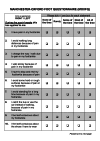Impact of Timing Surgical Fixation on Complications and Functional Outcomes in Ankle Fractures
- PMID: 39776711
- PMCID: PMC11705188
- DOI: 10.7759/cureus.75313
Impact of Timing Surgical Fixation on Complications and Functional Outcomes in Ankle Fractures
Abstract
Introduction: This study aimed to assess whether adherence to the British Orthopaedic Association Standards for Trauma (BOAST) and National Institute for Health and Care Excellence (NICE) guidelines for ankle fractures is associated with reduced complication rates and improved functional outcomes. Methods: A retrospective analysis was conducted of all patients who underwent surgical fixation for ankle fractures in August 2023 to January 2024 from an acute hospital. Statistical analyses were performed using IBM SPSS Statistics software, version 29 (IBM Corp., Armonk, NY), to explore the relationship between BOAST and NICE guideline adherence and the study outcomes.
Results: The analysis revealed that only 10% of patients underwent ankle surgical fixation in accordance with the BOAST and NICE guidelines, with the mean time for surgery from injury as 10.7 days for the remaining cohort. Mental health effects were also recognised, with 26.7% due to waiting times. The association between BOAST and NICE compliance and complication incidence was found to be non-significant (p = 0.414). Mean Manchester-Oxford Foot Questionnaire (MOXFQ) scores were lower in the BOAST and NICE-compliant groups. The correlation coefficient between surgical waiting time and MOXFQ scores was r = 0.007, demonstrating no significant correlation between the time to surgery from injury and functional outcomes.
Conclusions: This study highlights the challenges in adhering to BOAST and NICE guidelines for timely surgical intervention in ankle fractures, with only a small proportion of patients receiving surgery within the recommended timeframe. Larger-scale studies are required to substantiate the hypothesis that early surgical intervention, as per the guidelines, leads to improved outcomes and whether achievement of the guidelines is feasible or requires re-examination.
Keywords: ankle and foot; ankle fracture; boast; guideline; manchester-oxford foot questionnaire; orthopaedic; the national institute for health and care excellence (nice); timing; trauma; waiting time.
Copyright © 2024, Bin Sahl et al.
Conflict of interest statement
Human subjects: Consent for treatment and open access publication was obtained or waived by all participants in this study. Animal subjects: All authors have confirmed that this study did not involve animal subjects or tissue. Conflicts of interest: In compliance with the ICMJE uniform disclosure form, all authors declare the following: Payment/services info: All authors have declared that no financial support was received from any organization for the submitted work. Financial relationships: All authors have declared that they have no financial relationships at present or within the previous three years with any organizations that might have an interest in the submitted work. Intellectual property info: The Manchester-Oxford Foot Questionnaire (MOxFQ) requires license approval from Oxford University Innovation to be used. This has been requested from Clinical Outcomes at Oxford University Innovation from https://innovation.ox.ac.uk/outcome-measures/manchester-oxford-foot-questionnaire-moxfq/ and has been approved under order number MOxFQ-1660441. Other relationships: All authors have declared that there are no other relationships or activities that could appear to have influenced the submitted work.
Figures






Similar articles
-
The acute management of ankle fractures (Augment) study: A prospective trainee led national collaborative audit of the Boast 12 guidelines.Surgeon. 2021 Oct;19(5):e237-e244. doi: 10.1016/j.surge.2020.11.001. Epub 2021 Jan 5. Surgeon. 2021. PMID: 33414043
-
Comparison between a multicentre, collaborative, closed-loop audit assessing management of supracondylar fractures and the British Orthopaedic Association Standard for Trauma 11 (BOAST 11) guidelines.Bone Joint J. 2018 Mar 1;100-B(3):346-351. doi: 10.1302/0301-620X.100B3.BJJ-2017-0780.R2. Bone Joint J. 2018. PMID: 29589502
-
The Influence of Timing of Surgery on Postoperative Length of Hospital Stay in Closed Ankle Fractures.Cureus. 2024 Nov 14;16(11):e73692. doi: 10.7759/cureus.73692. eCollection 2024 Nov. Cureus. 2024. PMID: 39677206 Free PMC article.
-
Total ankle replacement versus ankle arthrodesis for patients aged 50-85 years with end-stage ankle osteoarthritis: the TARVA RCT.Health Technol Assess. 2023 Mar;27(5):1-80. doi: 10.3310/PTYJ1146. Health Technol Assess. 2023. PMID: 37022932 Free PMC article.
-
Arthroscopically assisted internal fixation for treatment of acute ankle fracture: A systematic review and meta-analysis of comparative studies.PLoS One. 2023 Aug 4;18(8):e0289554. doi: 10.1371/journal.pone.0289554. eCollection 2023. PLoS One. 2023. PMID: 37540648 Free PMC article.
References
-
- Patient outcomes following ankle fracture fixation. Chong HH, Hau MY, Mishra P, Rai P, Mangwani J. Foot Ankle Int. 2021;42:1162–1170. - PubMed
-
- The wait time for surgery following injury affects functional outcomes and complications after an ankle fracture: a propensity score-matched multicenter study, the TRON study. Sugino T, Takegami Y, Bando K, Sato T, Fujita T, Oka Y, Imagama S. Foot Ankle Spec. 2024;17:592–597. - PubMed
-
- BOAST- the management of ankle fractures. [ Jun; 2024 ]. 2016. https://www.boa.ac.uk/resource/boast-12-pdf.html https://www.boa.ac.uk/resource/boast-12-pdf.html
-
- The acute management of ankle fractures (Augment) study: a prospective trainee led national collaborative audit of the Boast 12 guidelines. Fennelly JT, Gourbault LJ, Stedman T, Price MJ, Ward AE. Surgeon. 2021;19:0–44. - PubMed
LinkOut - more resources
Full Text Sources
